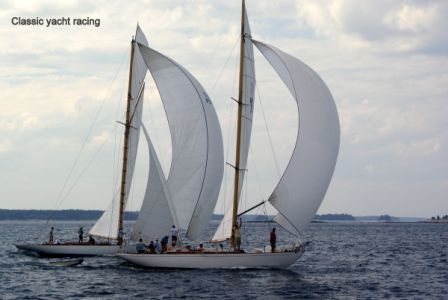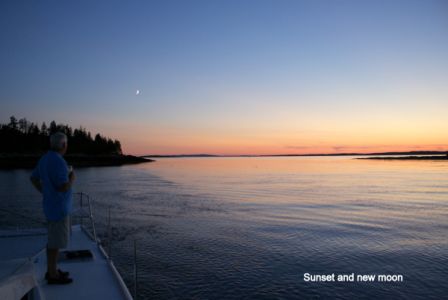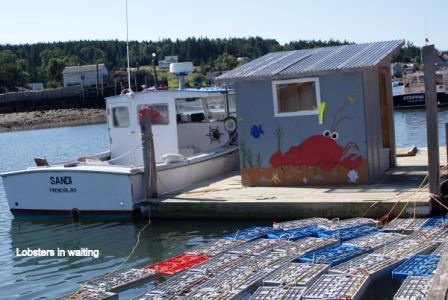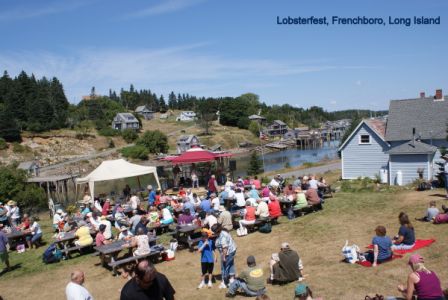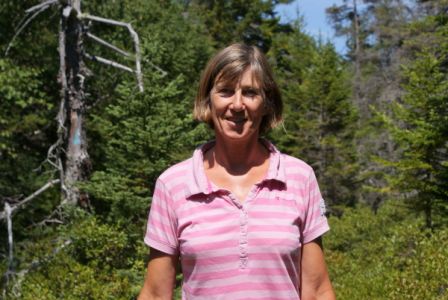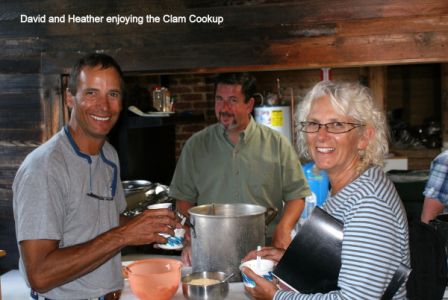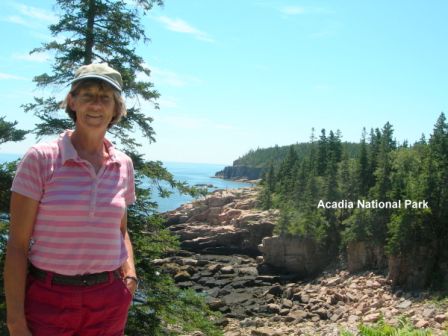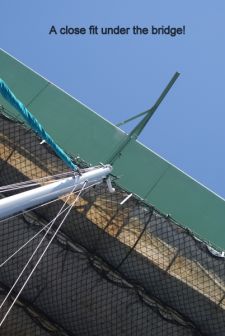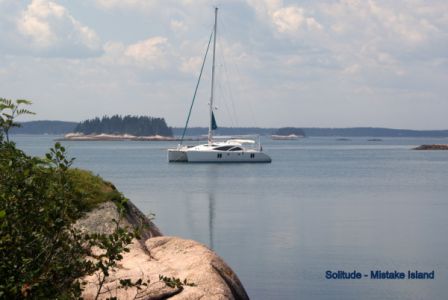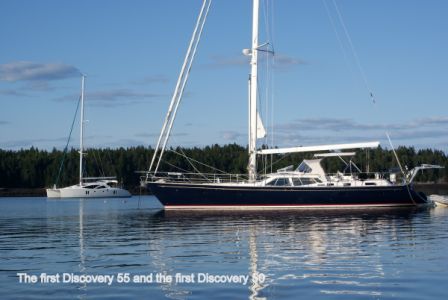Maine is an amazing cruising area. There are island studded bays,
small towns with good restaurants and historical centres, well-marked channels
between islands, little tide and secluded anchorages. Many of the islands are
clothed in pine forest which clings to the pink granite rock as it meets the
shoreline. Maine
does have fog, but that comes and goes, and in itself it can be quite
bewitching in the way it shrouds the landscape and diffuses the light. It
also has lobster pots.
Lobster pots
dominate your cruising in a way that I am sure is unique. It is largely
the sheer number - apparently over three million of them, partly the fact that
there is no concession to keeping a narrow channel clear, but also that some of
them are tied together in pairs – and woe betide you if your hull gets
between them! The concern is that you might get the floats that are
tied to the pots snarled up with your keel or worse still with your propeller,
causing damage to the shaft and stopping the engine (let alone damaging the
lobsterman’s trade. To avoid becoming paranoid about the field of
brightly-coloured floats which bob and dip in front of you, you have to decide
what your tactics are…. weaving around each pot can mean that you
very quickly go off course and potentially get in to danger; with a catamaran
you can try lining them up between the hulls, but the sheer number can make
that impossible. I have found that the best approach is a combination of
being fatalistic and embracing the problem as if it were a computer game
– a minefield that has to be negotiated, but if you get it wrong you will
probably lose some points but get another life. As it is, we have been
very lucky to have been sailing in company with David
and Heather who are on Sula
– Discovery 55 Hull number one
– as they have kindly dived down to assess the damage to our sail drive
from a rope.
The number
plates of cars from Maine
have “Vacationland” on them. It seems that Maine is having one of the best summers that
anyone can remember. Apart from a few thunderstorms at night and a couple of
days of fog – it’s quite something when the only way to find your
way back from the shore to your boat seems to be using your hand-held GPS
– we have woken to sunshine and clear skies every day. There is a
great feeling of bonhomie: we’ve been to the Seven Seas Cruising
Association get-together; we’ve had other yachties on board for coffee
and for drinks and met fellow cruisers at the local play. One couple
invited us to join them at a restaurant and lent us a pilot guidebook (Taft),
providing greater detail and historical cameos of the areas we are visiting.
We’ve even had people come over to us as they recognised us from the
article that has recently appeared in Blue Water Sailing magazine. Today,
not only have we been to a lobsterfest on Long Island that was recommended by a
sailor, but we also had time to nip over to Swan Island
to try the Chowder Cook-up that someone else was heading for. We were
warned about the height of the bridge over Eggemoggin Reach, but hadn’t
accounted for the repair work that was being carried out – with
scaffolding and sacking hanging from it we sailed under with just a tiny amount
to spare above the mast – a heart rendering moment.
Over the last
two weeks we have been meandering around the islands of Penobscot
Bay and Mount Desert Island. We have travelled
over 200 miles as we have also gone further east to the more remote area of Maine’s Bold
Coast, which neighbours Nova Scotia. (The water
there is a mere 13 degrees C – the seals love it, but I’m not so
certain.) We have seen eagles nesting in the pines trees and ospreys
nesting in the frame on top of marker buoys. By cycling out to the rugged
Schoodic Point, east of Mount Desert
Island, we were able to see eiders and guillemots in numbers.
Acadia National
Park, Mount Desert Island making up
the bulk of it, is the second most visited National Park, with over 3m visitors
a year. There are several towns on the island, Bar
Harbour being the biggest, but we
enjoyed the atmosphere in both Southwest and Northeast Harbours,
with their choice of good restaurants and shops, as well as the beautiful
anchorage at Somesville, which is at the head of a fjord. We cycled about
20 miles of the ‘carriageways’ which criss-cross part of the island,
are free from motor traffic and which offer some great scenery. Another
day we hopped on and off the free shuttle buses, walked the coastal path and
wandered around the very crowded Bar
Harbour.
Mount Desert became fashionable as a resort for the wealthy in the mid-19th
century. Statistics of a fire in 1947, which ravaged 25 square miles,
give a hint of the scale of its former glory, as 5 grand hotels, 60 summer
mansions and 170 year-round homes were destroyed. Fire seems to be a
tragic part of so much of the history around here, partly I guess because so
many of the buildings are timber-constructed. Unusually, in Belfast, many of the old
buildings were of elegant brick construction, but even there one building was
burnt twice in four years. Nevertheless, Americans are very proud of
their history and are very good at preserving their heritage. Even on the
outer islands that we have visited there is often a small museum to be found or
an old house that you can take a tour round. Small towns have signs
dotted around the streets explaining the historical significance or original
use of various buildings. One of the signs I saw on a building today said
“Life is not measured by the breaths we take but by the moments that take
our breath away.” - I think there have already been quite a
few moments like that on our


